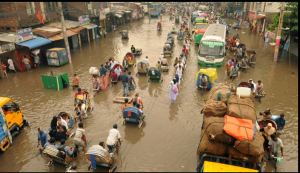Peter McCornick, International Water Management Institute
Negotiators at COP20 need to take a serious look at water. The more extreme temperatures we will now face are likely to alter the amounts and distribution of rainfall, river flows, groundwater availability, and snow melt. Both now and in the future, economic development and food security will depend on more effective management of this water variability.
The challenges are already becoming apparent. We may need to adapt to more flooding, for instance, planning our investments to better control and productively use the surplus water.And we will need to store more water. That doesn’t mean simply building more big dams and reservoirs – although this will be necessary in some regions. A mixed approach that combines major infrastructure with groundwater, wetlands and local ponds is likely to be more flexible and resilient.
Agriculture accounts for 70–80 per cent of global fresh water use. So making sure that enough water is available to grow food will be a fundamental task. Over the next 40 years, farmers will have to find ways to produce up to 70 per cent more to feed the burgeoning global population, while facing growing competition for resources from other sectors. At the same time, we need to reduce the impact of farming on already stressed ecosystems. This means making each unit of water produce more.
In many areas this is already happening. In the Mekong Delta, for example, farmers who have traditionally relied solely on monsoon flows have been gradually intensifying production in the drier seasons. By using groundwater or enhanced management of surface water, they have been able to produce more frequent and diverse harvests without expanding to new lands. Similar approaches show promise in parts of Africa as well. However, careful management, such as techniques to help re-charge aquifers, is often needed to ensure that this water use is sustainable.
With the impacts of climate change, availability of water is likely to be less predictable. Farmers have always lived with the vagaries of climate, such as rains coming earlier or later than usual, but uncertainties are increasing. Already we are witnessing changes in cropping patterns. For instance, following several years of low rainfall, farmers in Southwest India shifted from thirsty sugarcane to the water-frugal soybean – an adaptation to water scarcity that also gives them a better return.
Managing irrigation in these new conditions will be challenging, but there is equal concern about rainfed cropland, which produces 60 per cent of the world’s food. Here, a mixed approach is needed. Supplemental irrigation – applied only at the critical stages of crop growth – combined with better management of soil, nutrients and crops – can more than double water productivity and yields. Major increases in production can be achieved by this technique. New technologies such as simple pumps powered by fossil fuels, electricity, the sun, people or animals, and micro-irrigation techniques, ranging from clay pots to drippers, have catalysed this growth.
While farmers can be helped to adapt to climate variability and change at local level, the authority to plan and approve basin-wide projects will require high-level political engagement. Diverting water to facilitate the recharge of ground water, or reallocating water from canal irrigation to environmental flows, for instance, will require detailed analysis to help decision-makers understand the necessary trade-offs. International cooperation will be critical to manage water in river basins that cross multiple borders.
Part of the answer to smarter water management will be improving our collection of data. This underpins the comprehensive models that can advise policy makers and COP negotiators on how systems can be adapted without wrecking the natural systems which support agriculture. Yet decisions will also need to be made in data scarce environments, especially in the developing world.
We already have many of the technologies and techniques we need to make our water go further, and to protect ourselves from increasing variability. The challenge is to make this work in poor rural environments. This is not just a question of better water management, but of addressing some of the fundamental causes of poverty. Promoting broad-based sustainable agricultural development to lift rural communities out of poverty is, in itself, an effective climate adaptation strategy in rural areas. Water will underpin this growth. We need to use it wisely.
MORE INFO: Download ‘Tackling Change: Future-proofing water, agriculture and food security in an era of climate uncertainty’ www.iwmi.org – Outreach newsletter of the Stakeholders Forum




